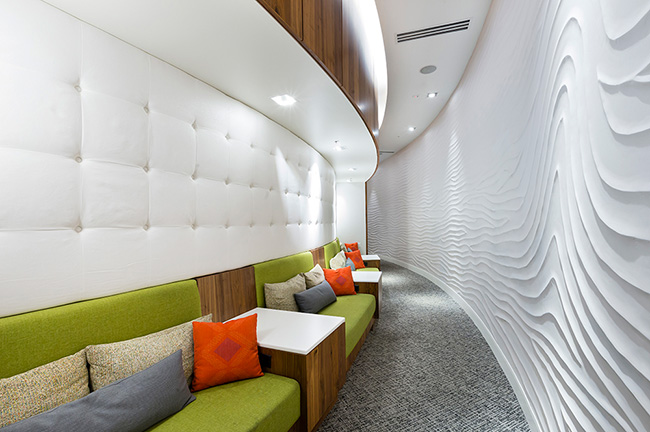The airport’s sense of place has always been an important one. Over 2.5 million people travel on over 43,000 flights each day in the United States.
With so many air passengers heading to a variety of destinations, it’s essential to find the one thing that makes the long lines, unexpected delays and early check-ins worthwhile: the airport lounge.
As air travelers have become more insightful through years of travel modifications, so too has the airport lounge and other airport spaces.
Evolution and Variations of the Airport Lounge
“Passengers who are forced to wait rather than do something that they would be doing outside the airport feel that time is wasted, which leads to bad reviews, frustration and a lack of airline or airport loyalty in a market that continues to become more value- and deal-oriented,” said Ginger Gee DiFurio, an aviation designer for Corgan.
[Related Content: United Announces Direct Service to Hilton Head]
Together, she and colleague Beth Schmidt have worked on numerous terminals, sky clubs for major airlines like Delta and American Airlines, American Express lounges and more around the world. With their combined experience of nearly 20 years in the field, both have noticed how, with the help of technology, aviation design has moved from efficient bag-and-passenger movement to more human-centric design.
“In the last 10 years, aviation design has evolved into evidence-based design, with passenger experience being one of the most important factors to consider,” DiFurio said.
She noted how airports today try to emulate the feeling of being the first destination in a journey and now include amenities, activities, entertainment and relaxation, so much so that passengers are encouraged to arrive early rather than wait for their departure or potential delays.
Exclusive Airport Lounge Amenities become Commonplace
This also means that once highly-sought-after Wi-Fi and recharging stations are now commonplace, as travelers expect more from the space that transports them to the next.
DiFurio and Schmidt pointed out two trends that have become must-haves in both the terminal and lounge: a feeling of local culture that provides a starting point for the passenger’s overall destination and a sense of exclusivity with featured amenities for club and airport lounge users.
“Airports really are the front door to cultures and locations, and as such they give us our first impression of what our trip may entail,” said DiFurio, who added that incorporating local materials and color palettes that exude the character of a city help instill this impression and can be a prideful representation for locals of their homes.
This reminded the duo of one of their favorite airport lounge projects: a curved sculptural wall they designed for the American Express Club at Miami International Airport.

American Express Club at Miami International Airport, Credit: Corgan
“The wall was intended to hold artwork, but due to the circular nature of the footprint and the limited space where passengers could back up and truly appreciate the individual pieces on the wall, we decided to make the entire wall into a piece of [art]work,” Schmidt said. “It really showcases a sense of place for Miami by imitating ripples of sand in the shallows of the beach.”
The Airport: Not Just a Place to Wait
Other highlights include biophilic benches that wrap around columns with integrated planters and aquariums. Hospitality-styled amenities, such as spas that host showers, manicures and haircuts, are also passenger favorites found within the club.

Biophilic Design at an Airport, Credit: Corgan
While airport spaces are seeing a rise in local cuisine, artwork and history being incorporated into the layout, DiFurio pointed out that airlines and companies have also upped the effort when it comes to incorporating picture-worthy backdrops, which can then be branded in such a way that it works to advertise for them as well, especially on travelers’ social media accounts.
“The social media aspect of travel and flight is more prominent than ever,” Schmidt said. “Terminals’ art programs provide unique opportunities with dramatic backdrops to show off jet-set lifestyles.
"The Doha bear [at Hamad International Airport] and the Sacramento big red rabbit grace Facebook feeds and Instagram stories frequently," she added. "Anything that gives the passenger the chance to express ‘I am here’ in a way that can’t be done anywhere else is a win.”
[Related Content: Benefits of Natural Light for Attendees]
Schmidt and DiFurio also find that the airport lounge, in particular, tends to be more custom-designed to reflect the different values and service ethos of each brand, and that they want to cater to their most valuable, frequent flier travelers.
“Many clubs, including those available with single-day passes, will highlight amenities like chef-made menus, spas and private working spaces, but the more exclusive clubs intended for high-mileage loyal passengers are more likely to limit average users and to offer a set of defined amenities that their passengers can expect at every stop,” DiFurio explained.
Schmidt added that highlighting exclusivity and class of one’s travel arrangements makes first class seating and an airport lounge a pride-filled location for travelers looking to photograph their activities.
Airport Lounge Innovation Continues to Grow
New heights (and lengths) continue to develop in the aviation field.
Qantas Airways announced earlier this year its first-ever nonstop commercial flight between Australia and the United Kingdom, making it the longest non-stop flight to date. New technology in development will help fight jet lag while traveling rather than asking travelers to deal with the side effects post-trip.
As DiFurio stated, “An airport is no longer just a machine moving people through; it is about placemaking, it is about hospitality, it is about entertainment and, most important, a destination.”
[Read This Next: 4 Simple Wayfinding Techniques to Help Guide Attendees]





![MPI Southern California Chapter's [WE]Con 2025 Opening Reception. Credit: Girl Squad Media.](/sites/default/files/styles/card_v2/public/2025-05/MPI%20Southern%20California%20Chapter%27s%20%5BWE%5DCon%202025%20Opening%20Reception.%20Credit%20Girl%20Squad%20Media..jpg.webp?itok=nW9yLuOA)

